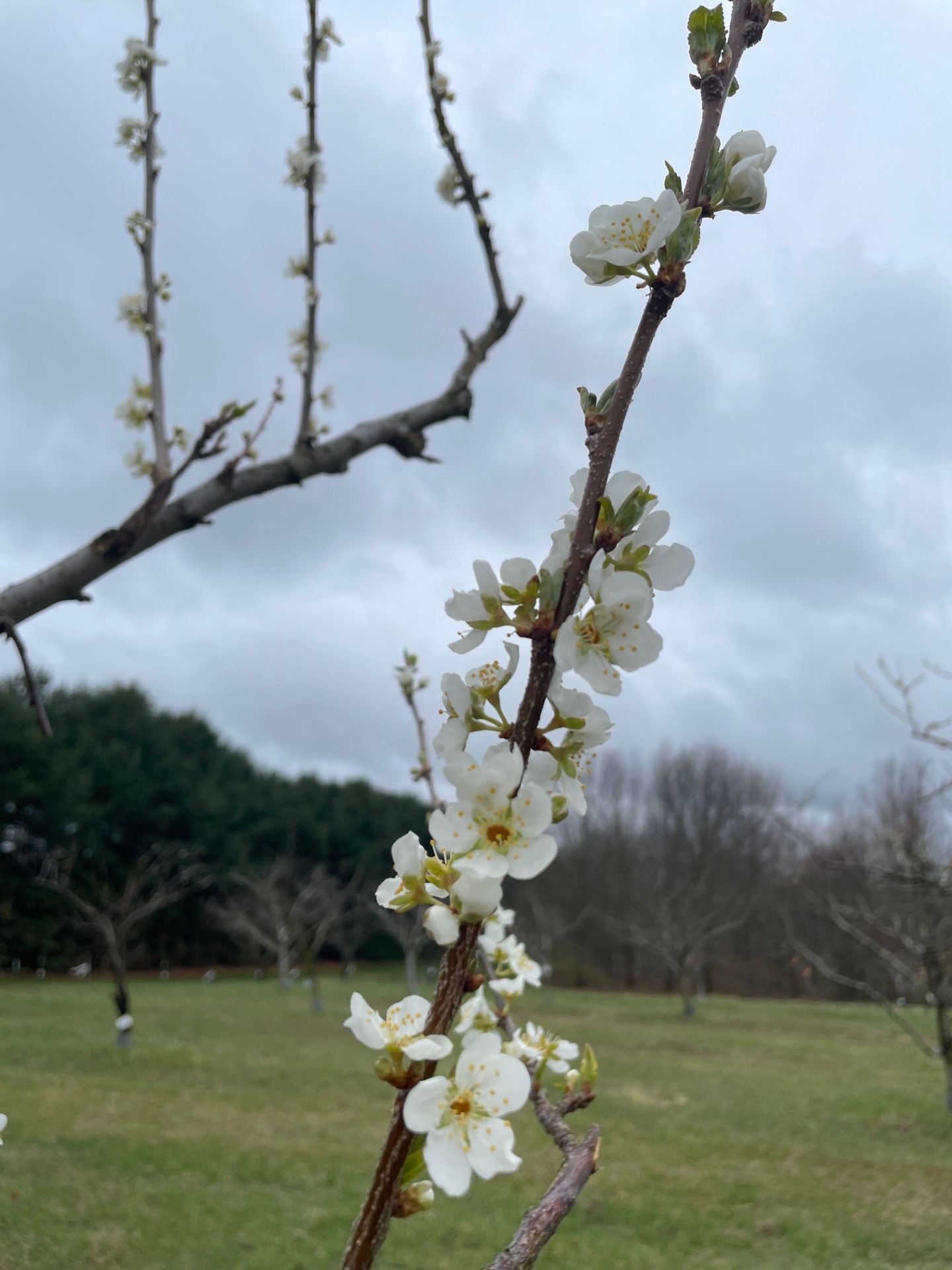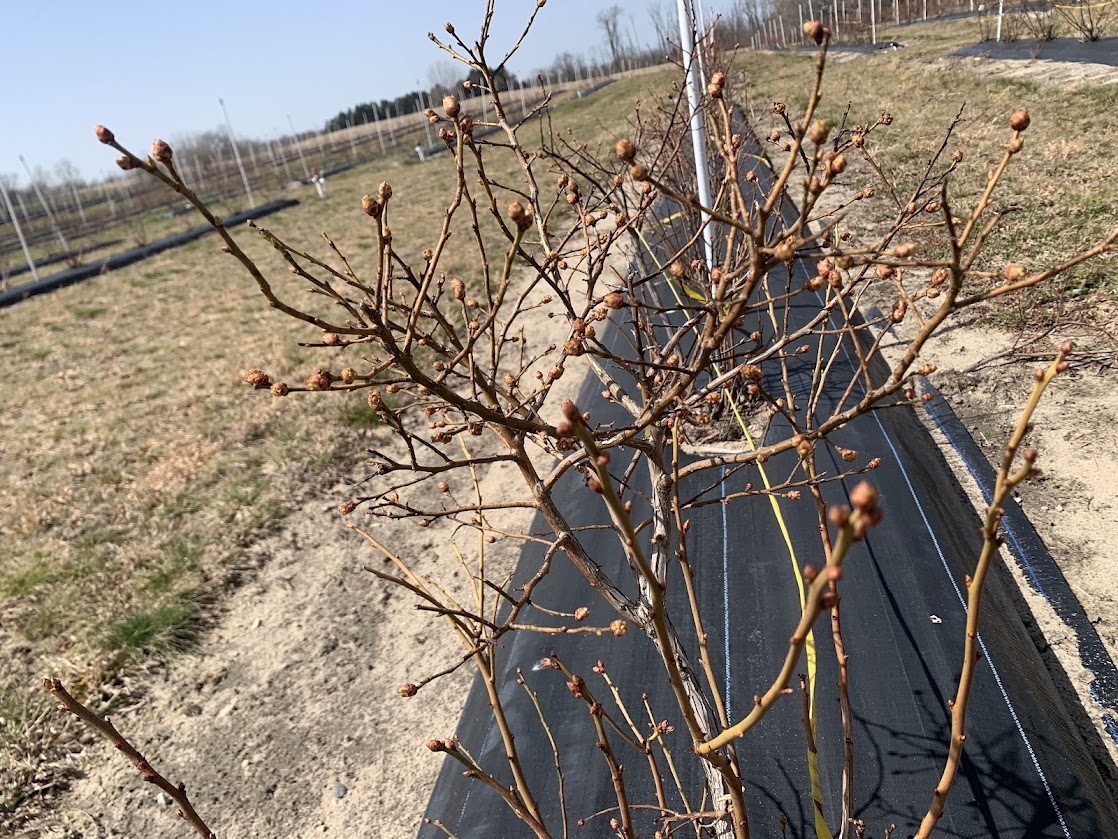Southwest Michigan fruit update – April 9, 2024
Current cool weather has slowed fruit crop development.

Last week in southwest Michigan, the weather was mixed, which is pretty typical of the transition from winter to spring. The week began with mild temperatures in the mid-40s, accompanied by intermittent rain showers. As the week progressed, temperatures gradually increased, reaching highs in the upper 50s to low 60s by midweek. However, this warmer trend was accompanied by lots of wind, with gusts reaching up to 25 mph at times. Towards the end of the week, the region experienced a brief return to cooler temperatures as a cold front swept through, bringing with it a chance of light snow showers and temperatures dipping back down into the 30s overnight.
Despite the fluctuations, overall the past week saw a transition towards more spring-like conditions.
This upcoming week, we can expect a continuation of this spring transition, with fluctuating temperatures and the continuation of varied conditions. The week is anticipated to start with mild temperatures in the low to mid-50s, accompanied by partly cloudy skies and occasional rain showers. As the week progresses, temperatures are forecasted to gradually rise, reaching highs in the upper 50s to low 60s by the weekend. However, this warmer trend may be interrupted by scattered thunderstorms and gusty winds, particularly towards the latter half of the week.
Despite the occasional bouts of inclement weather, overall the week is expected to see a continuation of the gradual warming trend.
Watch the latest weather report by Michigan State University Extension meteorologist Jeff Andresen.
|
Southwest Michigan growing degree day (GDD) summary from March 1 – April 8, 2024 |
|||
|---|---|---|---|
|
Station |
GDD 42 F |
GDD 45 F |
GDD 50 F |
|
Benton Harbor (SWMREC) |
193 |
143 |
82 |
|
Lawton (Lawton) |
192 |
142 |
79 |
|
Fennville (TNRC) |
162 |
117 |
64 |
|
Average for the SW region |
180 |
131 |
72 |
Tree fruit
Warmer temperature over the weekend has pushed along bloom development for tree fruit. Light rain occurred around the area on Sunday, increasing the opportunities for disease. Fruit buds will have significant damage with temperatures in the mid- to upper 20s degrees Fahrenheit and below.
Apricots are still in petal fall in central Berrien County. Brown rot infections are favored by wet conditions and temperatures over 50 F during bloom.
Peach and nectarine are at early to mid-bloom in Berrien County and full pink in Allegan County. Oriental fruit moth management is necessary in late April to prevent branch end damage that distorts tree structure.
In cherries, sweets are showing at white bloom tissue and tart cherries at tight cluster in central Berrien County. Brown rot can occur under a wide range of temperatures (40 to 86 F), but optimal temperature is 64 to 78 F, with 4-plus hours of wet conditions.
In plums, Shiro Japanese plum fruit buds at white bud to first bloom, Vanier is at full bloom and Stanley European plum are at tight cluster. Prune out black knot and dispose of the knots by burning or removing from the orchard. Sanitation is an important step in managing this disease.

Apple early variety Zestar is at late tight cluster, Macintosh and Gala are at tight cluster. Red Delicious, Goldens and Jonagold are at 0.5-inch green to early tight cluster in Berrien County. Apple scab ascospores continue to be caught in good numbers in area traps.
Pear (Bartlett and Harrow Sweet) fruit buds are at tight cluster to first white in Berrien County. Continued scab sprays are needed to protect green tissue against infection.
Small fruit
Grapes are starting to move. Bud swell is being reported in some juice grape locations and in some hybrids. Growers are still deciding how much damage they have from the January cold event and deciding pruning practices accordingly. Berrien County and eastern Van Buren County saw the coldest temperatures. Vinifera wine grapes show significant damage in these areas. Some hybrids have been affected in some of these locations as well. Juice grapes were largely unaffected. Allegan County has less damage and a decent vinifera crop is still expected. For growers looking to delay budbreak, some research indicates that oils such as Amigo oil sprayed on dormant buds can delay budbreak for a few days, but delayed pruning seems to have more consistent results.
Blueberry are beginning bud break in Berrien County up through Allegan County. With the warm weather this week, plants are expected to move quickly. Small amounts of green tissue were observed up through Fennville, Michigan, which means the window to apply dormant sprays like Sulforix or lime sulfur products to suppress early season diseases is closing quickly.
Want more blueberry specific content? Subscribe to Blueberry Bites!

Strawberry overwintering mulches should be removed and raked between the rows. Some growers are putting out floating row covers. Growers are looking at early season herbicides to control overwintering weeds. When selecting an herbicide, make sure and check the preharvest interval.
Many bramble growers are dormant pruning. In summer bearing raspberries, last year’s primocanes should be headed (cut back) to the desired height and any remaining floricanes from last year should be removed. Fall bearing raspberries should be cut or mowed to the ground. Lime sulfur treatments for anthracnose can still be applied.
Upcoming meetings
Our regular southwest Michigan Monday fruit integrated pest management updates will once again be a hybrid format. The meetings will be held in-person at the Southwest Michigan Research and Extension Center, 1791 Hillandale Rd, Benton Harbor, MI 49022, with virtual attending available online. Our first meeting is Monday, April 15, at 5:30 p.m. No advanced signup is needed for attending in-person. The meetings are free, and one pesticide applicator credit is available for each meeting.
Additional information and surveys
Michigan State University is running a pollinator survey this spring and summer to understand how people interact with pollinators in natural, urban and managed landscapes. The survey is anonymous and takes only 10-15 minutes to complete.
This work is supported by the Crop Protection and Pest Management Program [grant no 2021-70006-35450] from the USDA National Institute of Food and Agriculture. Any opinions, findings, conclusions, or recommendations expressed in this publication are those of the author(s) and do not necessarily reflect the view of the U.S. Department of Agriculture.



 Print
Print Email
Email


